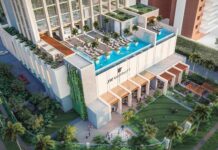After acquiring the San Francisco Airport Marriott Waterfront in 2012, Xenia Hotels and Resorts had immediate plans to embark on a guestroom renovation. But while they were working on the design, Marriott was simultaneously rolling out its Innovation Lab, a 10,000-square-foot design studio underneath the company’s Bethesda, Md.-headquarters where designers, employees, customers, and architects can co-collaborate to create the “perfect” hotel room of the future. When Xenia was ready to begin the renovation, the Innovation Lab wasn’t quite complete. So, the property made the most of the delay.
During any renovation process, it is typical to learn what works—and what decidedly does not work—through trial and error. It can be a long process, but ultimately the final product is better for the extra effort. With this in mind, Xenia not only anticipated regular adjustments to the plans but also encouraged them by incorporating guest feedback into the design.
“We figured that since we had time on our side, we should get some feedback from our customers and see what they like and if they have any suggestions,” explains General Manager Clif Clark, who has worked at the property since 2010. As an innovator for Marriott who partnered with the brand in piloting other concepts, such as the M Club Lounge, he was thrilled to try something new.
Taking advantage of Marriott’s enthusiasm to create the ideal room, Xenia collaborated with the brand and design firm Baskervill to convert three existing rooms into sample rooms for guests to try out. Marriott’s “Travel Brilliantly” campaign asks frequent guests to send in suggestions for all aspects of their ideal guestroom of the future—from technology to style—through its website. But by creating sample rooms, the San Francisco hotel took the initiative a step further, allowing guests to live in the rooms before making critiques.
While it sounds like a massive undertaking to involve guests in the planning process in real time, Xenia streamlined the process by asking frequent visitors to fill out simple questionnaires ranking aspects of the room on a scale of one to 10 in comparison to other hotel experiences. “We thought, what better group of individuals to give us some feedback than the people who have seen a lot of different products and hotel rooms?” Clark says.
Guests weighed in on everything from the type of glass used in the shower doors to settling the carpet-versus-wood flooring debate (carpet won; it was quieter for guests staying on the floor below). The number of ideas Clark anticipated would be a hit, only to be quickly struck down by guests, surprised even the 30-year hospitality veteran. For example, cool factor was no match for practicality in almost every instance.
“We had these really cool shades that were remote control-driven,” Clark says. “But guests could not figure out intuitively how to put the shades down. We had to provide directions, and we thought, ‘How stupid is that?’ When someone wants to open and close their drapes, they don’t want to have to read a manual. A lot of the time, it was just a combination between form and function.”
After nearly a year of testing, the $18 million renovation of the hotel’s 688 guestrooms came to fruition, incorporating a mix of guest feedback and Marriott’s room-of-the-future research. The final result was a calming environment in hues of blue and gray to denote the property’s Bay Area location, and the extra time into to planning the renovation has resulted in skyrocketing post-renovation satisfaction scores, Clark says.
“To me, that’s really where the rubber meets the road,” he says. “If the guests respond well to it, that means you have what they want.”











